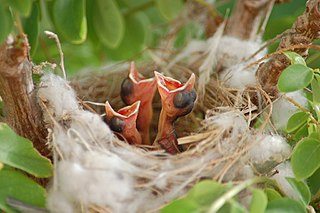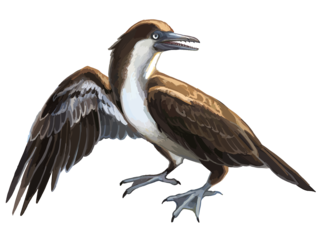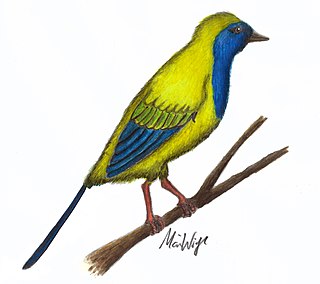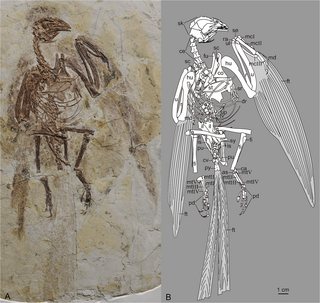
The megapodes, also known as incubator birds or mound-builders, are stocky, medium-large, chicken-like birds with small heads and large feet in the family Megapodiidae. Their name literally means "large foot" and is a reference to the heavy legs and feet typical of these terrestrial birds. All are browsers, and all but the malleefowl occupy wooded habitats. Most are brown or black in color. Megapodes are superprecocial, hatching from their eggs in the most mature condition of any bird. They hatch with open eyes, bodily coordination and strength, full wing feathers, and downy body feathers, and are able to run, pursue prey, and in some species, fly on the same day they hatch.

Fledging is the stage in a flying animal's life between hatching or birth and becoming capable of flight. This term is most frequently applied to birds, but is also used for bats. For altricial birds, those that spend more time in vulnerable condition in the nest, the nestling and fledging stage can be the same. For precocial birds, those that develop and leave the nest quickly, a short nestling stage precedes a longer fledging stage.

In biology, altricial species are those in which the young are underdeveloped at the time of birth, but with the aid of their parents mature after birth.
Nidifugous organisms are those that leave the nest shortly after hatching or birth. The term is derived from Latin nidus for "nest" and fugere, meaning "to flee". The terminology is most often used to describe birds and was introduced by Lorenz Oken in 1816. The chicks of birds in many families, such as the waders, waterfowl, and gamebirds, are usually nidifugous.

The Enantiornithes, also known as enantiornithines or enantiornitheans in literature, are a group of extinct avialans, the most abundant and diverse group known from the Mesozoic era. Almost all retained teeth and clawed fingers on each wing, but otherwise looked much like modern birds externally. Over eighty species of Enantiornithes have been named, but some names represent only single bones, so it is likely that not all are valid. The Enantiornithes became extinct at the Cretaceous–Paleogene boundary, along with Hesperornithes and all other non-avian dinosaurs.

Yanornis is an extinct genus of fish-eating Early Cretaceous birds. Two species have been described, both from Liaoning province, China: Yanornis martini, based on several fossils found in the 120-million-year-old Jiufotang Formation at Chaoyang, and Yanornis guozhangi, from the 124-million-year-old Yixian Formation.
Gobipteryx is a genus of prehistoric bird from the Campanian Age of the Late Cretaceous Period. It is not known to have any direct descendants. Like the rest of the enantiornithes clade, Gobipteryx is thought to have gone extinct near the end of the Cretaceous.

The Nicobar megapode or Nicobar scrubfowl is a megapode found in some of the Nicobar Islands (India). Like other megapode relatives, it builds a large mound nest with soil and vegetation, with the eggs hatched by the heat produced by decomposition. Newly hatched chicks climb out of the loose soil of the mound and being fully feathered are capable of flight. The Nicobar Islands are on the edge of the distribution of megapodes, well separated from the nearest ranges of other megapode species. Being restricted to small islands and threatened by hunting, the species is vulnerable to extinction. The 2004 tsunami is believed to have wiped out populations on some islands and reduced populations on several others.

Longipteryx is a genus of prehistoric bird which lived during the Early Cretaceous. It contains a single species, Longipteryx chaoyangensis. Its remains have been recovered from the Jiufotang Formation at Chaoyang in Liaoning Province, China. Apart from the holotype IVPP V 12325 - a fine and nearly complete skeleton — another entire skeleton and some isolated bones are known to date.
Eoalulavis is a monotypic genus of enantiornithean bird that lived during the Barremian, in the Lower Cretaceous around 125 million years ago. The only known species is Eoalulavis hoyasi.

Liaoxiornis is a dubious genus of enantiornithine bird. The only named species is Liaoxiornis delicatus, described by Hou and Chen in 1999. Because the species was named for a hatchling specimen, it cannot be matched with adult specimens, and so it is impossible to determine which, if any, birds from the same rocks represent adults of this species. Luis Chiappe and colleagues therefore regarded it as a nomen vanum or at least a nomen dubium, and recommended that use of the name be abandoned.
Paraprotopteryx is a genus of enantiornithean birds from the Mesozoic of China.

Protopteryx is an extinct genus of bird and the most basal enantiornithean, from the Cretaceous period. The type species is P. fengningensis. It was first discovered in the Sichakou Member of the Yixian Formation or Huajiying Formation of Hebei Province, northern China, dating from 131 Ma ago. Protopteryx has been found in the Daibeigou formation, as well. The name Protopteryx means "primitive feather": "proto-" meaning "the first of" and "-pteryx" meaning "feather" or "wing." The name comes from the fact that Protopteryx feathers are more primitive than those of modern birds, such as the two elongated tail feathers that lack barbs and rami.
A nidicolous animal is an animal that stays at its birthplace for a long time because it depends on the parents for food, protection, and the learning of survival skills. They are the opposite of nidifugous species, which leave their parents more quickly and survive independently.

Longipterygidae is a family of early enantiornithean birds from the early Cretaceous Period of China. All known specimens come from the Jiufotang Formation and Yixian Formation, dating to the early Aptian age, 125-120 million years ago.

Bohaiornis is a genus of enantiornithean birds. Fossils have been found from the Lower Cretaceous Jiufotang Formation of western Liaoning, China. The only known species, Bohaiornis guoi, was named by Dongyu Hu, Li Li, Lianhaim Hou and Xing Xu in 2011 on the basis of a fully articulated and well-preserved skeleton of a sub-adult. This specimen, LPM B00167, preserved two long, ribbon-like feathers attached to the tail rather than a fan of shorter pennaceous feathers. It was similar to the slightly older Eoenantiornis, but much larger in size. Bohaiornis is the type species of Bohaiornithidae, a family of large predatory enantiornitheans from the Early Cretaceous.

Pengornithidae is a group of early enantiornithines from the early Cretaceous Period of China, with the putative member Falcatakely possibly extending this clade's range into the Late Cretaceous of Madagascar, and several putative pengornithids also hail from this formation. Specimens of these animals have been found both in the Huajiying Formation and Jiufotang Formation of Liaoning and Hebei provinces, dating from the Hauterivian age to the Aptian age.

Parapengornis is an extinct genus of enantiornithine bird from the Lower Cretaceous of what is now China. The holotype specimen was discovered in the Jiufotang Formation near Lingyuan, western Liaoning province, and was catalogued as IVPP V18687. The nearly complete, articulated specimen is preserved on a slab and has impressions of pennaceous feathers. Only parts of the sternum, the left hand, and right foot are missing. In 2015, it became the basis of the new genus and species Parapengornis eurycaudatus, named by the Chinese palaeontologists Han Hu, Jingmai K. O’Connor, and Zhonghe Zhou. The generic name consists of the Latin word para and the name of the related genus Pengornis, indicating their close relationship. The name Pengornis is itself derived from "Peng", a mythological bird from Chinese folklore, and ornis, which means bird in Greek. The specific name is derived from the Latin words eury, meaning broad, and caudatus, meaning tail, in reference to the broad and expanded pygostyle. A nearly complete specimen formerly assigned to Pengornis was also reassigned to Parapengornis by these authors.

Jingmai Kathleen O'Connor is a paleontologist who works as a curator at the Field Museum.
















